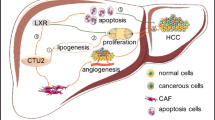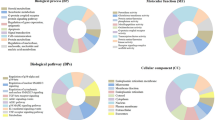Abstract
In the present study, we investigate the anti-cancer activity and mechanism of caudatin, the C-21 steroidal glycosides, on human hepatoma cell line HepG2. The MTT assay and flow cytometry were used to evaluate HepG2 cell proliferation and cell cycle. Annexin-V/PI and DAPI staining were used to investigate cell apoptosis. Western blotting analysis was used to evaluate the expression levels of proteins. It is found that caudatin inhibits HepG2 cell growth and induces of G0/G1 phase arrest in a dose dependent manner, which is associated with a decreased in the expression of cyclinD1 and increased the levels of p21 and p53. HepG2 cells dealing with caudatin showed typical characteristics of apoptosis. Western blotting analysis indicated that the levels of Bcl-2 were down-regulated after caudatin treatment, whereas the expression of Bax was up-regulated. Furthermore, caudatin-induced apoptosis was accompanied by activation of caspase-3, -9, and poly(ADP-Ribose) Polymerase (PARP). Treatment with caudatin also induced phosphorylation of extracellular-signal regulating kinase (ERK) and c-Jun N-terminal kinase (JNK). These results demonstrate that caudatin inhibits cell proliferation via DNA synthesis reduction and induces caspase-dependent apoptosis in HepG2 cell. Activation of ERK and JNK may be involved in caudatin-induced hepatoma cell apoptosis.








Similar content being viewed by others
References
Parkin DM, Bray F, Ferlay J, Pisani P (2005) Global cancer statistics, 2002. CA Cancer J Clin 55:74–108
Charette N, De Saeger C, Lannoy V, Horsmans Y, Leclercq I, Starkel P (2010) Salirasib inhibits the growth of hepatocarcinoma cell lines in vitro and tumor growth in vivo through ras and mTOR inhibition. Mol Cancer 9:256. doi:10.1186/1476-4598-9-256
Su M, Wu X, Chung HY, Li Y, Ye W (2009) Antiproliferative activities of five Chinese medicinal herbs and active compounds in Elephantopus scaber. Nat Prod Commun 4:1025–1030
Chang C, Zhu Y, Tang X, Tao W (2010) The anti-proliferative effects of norcantharidin on human HepG2 cells in cell culture. Mol Biol Rep. doi:10.1007/s11033-010-0090-6
Zhang R, Liu Y, Wang Y, Ye Y, Li X (2007) Cytotoxic and apoptosis-inducing properties of auriculoside A in tumor cells. Chem Biodivers 4:887–892. doi:10.1002/cbdv.200790076
Peng YR, Li YB, Liu XD, ZhangJF Duan JA (2008) Apoptosis induced by caudatin in human hepatoma cell line SMMC7721. Chin J Nat Med 6:210–213
Brunelle JK, Letai A (2009) Control of mitochondrial apoptosis by the Bcl-2 family. J Cell Sci 122:437–441. doi:10.1242/jcs.031682
Zhu J, Zhang L, Jin X, Han X, Sun C, Yan J (2010) beta-Ionone-induced apoptosis in human osteosarcoma (U2os) cells occurs via a p53-dependent signaling pathway. Mol Biol Rep 37:2653–2663. doi:10.1007/s11033-009-9793-y
Jarpe MB, Widmann C, Knall C, Schlesinger TK, Gibson S, Yujiri T, Fanger GR, Gelfand EW, Johnson GL (1998) Anti-apoptotic versus pro-apoptotic signal transduction: checkpoints and stop signs along the road to death. Oncogene 17:1475–1482. doi:10.1038/sj.onc.1202183
Yuen MF, Hou JL, Chutaputti A (2009) Asia Pacific working party on prevention of hepatocellular carcinoma hepatocellular carcinoma in the Asia pacific region. J Gastroenterol Hepatol 24:346–353. doi:10.1111/j.1440-1746.2009.05784.x
Xiao D, Herman-Antosiewicz A, Antosiewicz J, Xiao H, Brisson M, Lazo JS, Singh SV (2005) Diallyl trisulfide-induced G(2)-M phase cell cycle arrest in human prostate cancer cells is caused by reactive oxygen species-dependent destruction and hyperphosphorylation of Cdc 25 C. Oncogene 24:6256–6268. doi:10.1038/sj.onc.1208759
Alfonso LF, Srivenugopal KS, Arumugam TV, Abbruscato TJ, Weidanz JA, Bhat GJ (2009) Aspirin inhibits camptothecin-induced p21CIP1 levels and potentiates apoptosis in human breast cancer cells. Int J Oncol 34:597–608
Singh SV, Herman-Antosiewicz A, Singh AV, Lew KL, Srivastava SK, Kamath R, Brown KD, Zhang L, Baskaran R (2004) Sulforaphaneinduced G2/M phase cell cycle arrest involves checkpoint kinase 2 mediated phosphorylation of Cdc25C. J Biol Chem 279:25813–25822. doi:10.1074/jbc.M313538200
Lapenna S, Giordano A (2009) Cell cycle kinases as therapeutic targets for cancer. Nat Rev Drug Discov 8:547–566. doi:10.1038/nrd2907
Satyanarayana A, Kaldis P (2009) Mammalian cell-cycle regulation: several Cdks, numerous cyclins and diverse compensatory mechanisms. Oncogene 28:2925–2939. doi:10.1038/onc.2009.170
Heath-Engel HM, Chang NC, Shore GC (2008) The endoplasmic reticulum in apoptosis and autophagy: role of the BCL-2 protein family. Oncogene 27:6419–6433. doi:10.1038/onc.2008.309
Youle RJ, Strasser A (2008) The BCL-2 protein family: opposing activities that mediate cell death. Nat Rev Mol Cell Biol 9:47–59. doi:10.1038/nrm2308
Kumar S (2007) Caspase function in programmed cell death. Cell Death Differ 14:32–43. doi:10.1038/sj.cdd.4402060
Allan LA, Clarke PR (2009) Apoptosis and autophagy: regulation of caspase-9 by phosphorylation. FEBS J 276:6063–6073. doi:10.1111/j.1742-4658.2009.07330.x
Yun SI, Yoon HY, Chung YS (2009) Glycogen synthase kinase-3beta regulates etoposide-induced apoptosis via Bcl-2 mediated caspase-3 activation in C3H10T1/2 cells. Apoptosis 14:771–777. doi:10.1007/s10495-009-0348-4
Droga-Mazovec G, Bojic L, Petelin A, Ivanova S, Romih R, Repnik U, Salvesen GS, Stoka V, Turk V, Turk B (2008) Cysteine cathepsins trigger caspase-dependent cell death through cleavage of bid and antiapoptotic Bcl-2 homologues. J Biol Chem 283:19140–19150. doi:10.1074/jbc.M802513200
Wagner EF, Nebreda AR (2009) Signal integration by JNK and p38 MAPK pathways in cancer development. Nat Rev Cancer 9:537–549. doi:10.1038/nrc2694
Xie P, Guo S, Fan Y, Zhang H, Gu D, Li H (2009) Atrogin-1/MAFbx enhances simulated ischemia/reperfusion-induced apoptosis in cardiomyocytes through degradation of MAPK phosphatase-1 and sustained JNK activation. J Biol Chem 284:5488–5496. doi:10.1074/jbc.M806487200
Chen YS, Li HR, Lin M, Chen G, Xie BS, Xu NL, Lin LF (2010) Livin abrogates apoptosis of SPC-A1 cell by regulating JNKI signaling pathway. Mol Biol Rep 37:2241–2247. doi:10.1007/s11033-009-9711-3
Milne DM, Campbell DG, Caudwell FB, Meek DW (1994) Phosphorylation of the tumor suppressor protein p53 by mitogen-activated protein kinases. J Biol Chem 269:9253–9260
Acknowledgments
This work was supported by grants from the National Natural Science Foundation of China (No 30800422).
Author information
Authors and Affiliations
Corresponding author
Rights and permissions
About this article
Cite this article
Fei, H.R., Chen, H.L., Xiao, T. et al. Caudatin induces cell cycle arrest and caspase-dependent apoptosis in HepG2 cell. Mol Biol Rep 39, 131–138 (2012). https://doi.org/10.1007/s11033-011-0721-6
Received:
Accepted:
Published:
Issue Date:
DOI: https://doi.org/10.1007/s11033-011-0721-6




